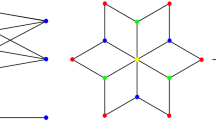Abstract
In 1955 Alexandrov [2, 7, p. 147] introduced the method of planar reflection as a procedure for proving symmetry of closed surfaces of constant mean curvature. In subsequent years, a number of refinements were given, and the method was applied successfully to other problems in differential geometry and partial differential equations, cf. [10, 5, 12, 9, 3, 12]. In the present paper, we introduce a new procedure for obtaining symmetry which may be considered an extension of the planar reflection method to reflection about spheres.
In the interest of clearly delineating the new features of the method, in this initial presentation we give a new proof of the original Alexandrov theorem: A closed embedded surface of constant mean curvature in Euclidean space is a round sphere. Our proof of this result is not simpler than that of Alexandrov; it is, however, different in some crucial respects.
Our justification for introducing the new procedure lies in its applicability to configurations that are not accessible to planar reflection arguments. In particular, we use the new method in [8] to prove the non-existence in certain cases of embedded liquid bridges joining two planes that meet to form a wedge domain, a result whose interest derives in turn largely from the fact that under the same (physical) boundary conditions embedded bridges do exist and can be stable when the planes are parallel.
The method of spherical reflection as presented below relies on a new maximum principle related to surface geometry, which we believe to have independent interest. Further, the method utilizes a peculiar characterization of spherical surfaces by aggregate symmetry, which should also have interest for other problems arising in the global differential geometry of surfaces.
Similar content being viewed by others
References
Ahlfors, L.V.Complex Analysis, McGraw-Hill, New York, 1979.
Alexandrov, A.D. Uniqueness theorems for surfaces in the large, V.Vestnik Leningrad University,19(13), 5–24, (1958).
Allegretto, W. and Siegel, D. Picone’s identity and the moving planes procedure,Electron. J. Differential Equations,14, (1995).
Beardon, A.F.The Geometry of Discrete Groups, Springer-Verlag, New York, 1983.
Gidas, B., Ni, W.-M., and Nirenberg, L. Symmetry and related properties via the maximum principle,Comm. Math. Phys.,68(2), 209–243, (1979).
Gilbarg, D. and Trudinger, N.S.Elliptic Partial Differential Equations of Second Order, 2nd ed., Springer-Verlag, Berlin, 1983.
Hopf, H.Differential Geometry in the Large, Springer-Verlag, Berlin, 1989.
McCuan, J. Symmetry via spherical reflection and spanning drops in a wedge,Pacific J. Math.,180(2), (1997).
Schoen, R.M. Uniqueness, symmetry, and embeddedness of minimal surfaces,J. Diff. Geom.,18, 791–809, (1983).
Serrin, J. A symmetry problem in potential theory,Arch. Rat. Mech. Anal.,43, 304–318, (1971).
Springer, G.Introduction to Riemann Surfaces, Chelsea, New York, 1981.
Wente, H.C. The symmetry of sessile and pendant drops,Pacific J. Math.,88(2), 387–397, (1980).
Author information
Authors and Affiliations
Corresponding author
Rights and permissions
About this article
Cite this article
McCuan, J. Symmetry via spherical reflection. J Geom Anal 10, 545–564 (2000). https://doi.org/10.1007/BF02921949
Received:
Issue Date:
DOI: https://doi.org/10.1007/BF02921949




